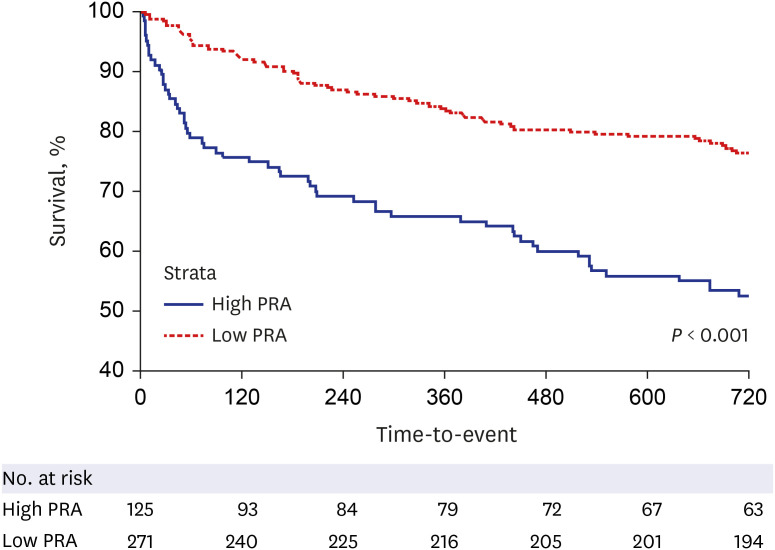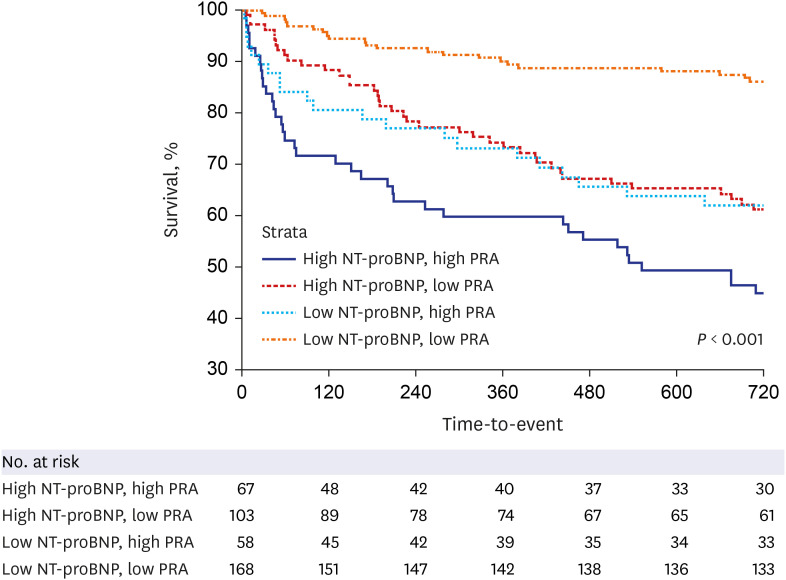J Korean Med Sci.
2020 Nov;35(42):e351. 10.3346/jkms.2020.35.e351.
Incremental Predictive Value of Plasma Renin Activity as a Prognostic Biomarker in Patients with Heart Failure
- Affiliations
-
- 1Department of Internal Medicine, Kyungpook National University Hospital, Daegu, Korea
- 2Department of Internal Medicine, School of Medicine, Kyungpook National University, Daegu, Korea
- 3Cardiology Center, Kyungpook National University Chilgok Hospital, Daegu, Korea
- KMID: 2508428
- DOI: http://doi.org/10.3346/jkms.2020.35.e351
Abstract
- Background
The association of N-terminal pro-B type natriuretic peptide (NT-proBNP) and plasma renin activity (PRA) for the prognosis of the patients with acute heart failure (HF) has not been fully investigated. This study aimed to determine the association between NT-proBNP and PRA and to investigate the incremental value of PRA to NT-proBNP for predicting long term prognosis in patients with acute HF.
Methods
Three hundred and ninety-six patients (mean age, 64.7 ± 15.9 years; 46.5% female) presenting with acute HF were enrolled between December 2004 and July 2013. Patients with newly diagnosed HF as well as patients with acute exacerbated chronic HF were included. The prognosis was assessed with the composite event of all-cause mortality and readmission for HF during a 2-year follow-up period.
Results
The etiology of HF was ischemic in 116 (29.3%) patients. In a Cox proportional hazards model, log-transformed PRA (hazard ratio [HR], 1.205; P = 0.007) was an independent predictor of the composite outcome of all-cause mortality and readmission for HF in addition to age (HR, 1.032; P = 0.001), white blood cell (WBC) count (HR, 1.103; P< 0.001), and left ventricular ejection fraction (LVEF) (HR, 0.978; P = 0.013). Adding PRA to age, sex, LVEF, and NT-proBNP significantly improved the prediction for the composite outcome of all-cause mortality and readmission for HF, as shown by the net reclassification improvement (0.47; P < 0.001) and integrated discrimination improvement (0.10; P < 0.001).
Conclusion
PRA could provide incremental predictive value to NT-proBNP for predicting long term prognosis in patients with acute HF.
Keyword
Figure
Reference
-
1. Emdin M, Vittorini S, Passino C, Clerico A. Old and new biomarkers of heart failure. Eur J Heart Fail. 2009; 11(4):331–335. PMID: 19329823.
Article2. Khanam SS, Choi E, Son JW, Lee JW, Youn YJ, Yoon J, et al. Validation of the MAGGIC (Meta-Analysis Global Group in Chronic Heart Failure) heart failure risk score and the effect of adding natriuretic peptide for predicting mortality after discharge in hospitalized patients with heart failure. PLoS One. 2018; 13(11):e0206380. PMID: 30485284.
Article3. Lee JH, Kim MS, Kim EJ, Park DG, Cho HJ, Yoo BS, et al. KSHF guidelines for the management of acute heart failure: Part I. Definition, epidemiology and diagnosis of acute heart failure. Korean Circ J. 2019; 49(1):1–21. PMID: 30637993.
Article4. Braunwald E. Biomarkers in heart failure. N Engl J Med. 2008; 358(20):2148–2159. PMID: 18480207.
Article5. Schmieder RE, Hilgers KF, Schlaich MP, Schmidt BM. Renin-angiotensin system and cardiovascular risk. Lancet. 2007; 369(9568):1208–1219. PMID: 17416265.
Article6. Laragh JH. The renin system and future trends in management of high blood pressure. Clin Exp Hypertens. 1980; 2(3-4):525–552. PMID: 6253242.
Article7. Laragh JH, Sealey JE. Abnormal sodium metabolism and plasma renin activity (renal renin secretion) and the vasoconstriction volume hypothesis: implications for pathogenesis and treatment of hypertension and its vascular consequences (heart attack, stroke). Clin Chem. 1991; 37(10 Pt 2):1820–1827. PMID: 1914196.
Article8. Brunner HR, Gavras H, Laragh JH. Specific inhibition of the renin-angiotensin system: a key to understanding blood pressure regulation. Prog Cardiovasc Dis. 1974; 17(2):87–98. PMID: 4369198.
Article9. Brunner HR, Laragh JH, Baer L, Newton MA, Goodwin FT, Krakoff LR, et al. Essential hypertension: renin and aldosterone, heart attack and stroke. N Engl J Med. 1972; 286(9):441–449. PMID: 4257928.
Article10. Brunner HR, Sealey JE, Laragh JH. Renin as a risk factor in essential hypertension: more evidence. Am J Med. 1973; 55(3):295–302. PMID: 4746557.
Article11. Jang SY, Chae SC, Bae MH, Lee JH, Yang DH, Park HS, et al. Effect of renin-angiotensin system blockade in patients with severe renal insufficiency and heart failure. Int J Cardiol. 2018; 266:180–186. PMID: 29887444.
Article12. Latini R, Masson S, Anand I, Salio M, Hester A, Judd D, et al. The comparative prognostic value of plasma neurohormones at baseline in patients with heart failure enrolled in Val-HeFT. Eur Heart J. 2004; 25(4):292–299. PMID: 14984917.
Article13. Harrell FE Jr, Lee KL, Mark DB. Multivariable prognostic models: issues in developing models, evaluating assumptions and adequacy, and measuring and reducing errors. Stat Med. 1996; 15(4):361–387. PMID: 8668867.
Article14. DeLong ER, DeLong DM, Clarke-Pearson DL. Comparing the areas under two or more correlated receiver operating characteristic curves: a nonparametric approach. Biometrics. 1988; 44(3):837–845. PMID: 3203132.
Article15. Pencina MJ, D'Agostino RB Sr, D'Agostino RB Jr, Vasan RS. Evaluating the added predictive ability of a new marker: from area under the ROC curve to reclassification and beyond. Stat Med. 2008; 27(2):157–172. PMID: 17569110.
Article16. Swedberg K, Eneroth P, Kjekshus J, Wilhelmsen L. CONSENSUS Trial Study Group. Hormones regulating cardiovascular function in patients with severe congestive heart failure and their relation to mortality. Circulation. 1990; 82(5):1730–1736. PMID: 2225374.17. Packer M. Pathophysiology of chronic heart failure. Lancet. 1992; 340(8811):88–92. PMID: 1352022.
Article18. Francis GS, Cohn JN, Johnson G, Rector TS, Goldman S, Simon A. Plasma norepinephrine, plasma renin activity, and congestive heart failure. Relations to survival and the effects of therapy in V-HeFT II. The V-HeFT VA Cooperative Studies Group. Circulation. 1993; 87(6):Suppl. VI40–VI48. PMID: 8500238.19. Benedict CR, Johnstone DE, Weiner DH, Bourassa MG, Bittner V, Kay R, et al. Relation of neurohumoral activation to clinical variables and degree of ventricular dysfunction: a report from the Registry of Studies of Left Ventricular Dysfunction. J Am Coll Cardiol. 1994; 23(6):1410–1420. PMID: 7909822.
Article20. Levine TB, Francis GS, Goldsmith SR, Simon AB, Cohn JN. Activity of the sympathetic nervous system and renin-angiotensin system assessed by plasma hormone levels and their relation to hemodynamic abnormalities in congestive heart failure. Am J Cardiol. 1982; 49(7):1659–1666. PMID: 7044086.
Article21. Mukoyama M, Nakao K, Hosoda K, Suga S, Saito Y, Ogawa Y, et al. Brain natriuretic peptide as a novel cardiac hormone in humans. Evidence for an exquisite dual natriuretic peptide system, atrial natriuretic peptide and brain natriuretic peptide. J Clin Invest. 1991; 87(4):1402–1412. PMID: 1849149.
Article22. Rachwan RJ, Butler J, Collins SP, Cotter G, Davison BA, Senger S, et al. Is plasma renin activity associated with worse outcomes in acute heart failure? A secondary analysis from the BLAST-AHF trial. Eur J Heart Fail. 2019; 21(12):1561–1570. PMID: 31646707.
Article
- Full Text Links
- Actions
-
Cited
- CITED
-
- Close
- Share
- Similar articles
-
- A Study on the Change of Plasma Renin Activity(PRA) and Aldosterone Concentration(PAC) before and after Heart Operation in Children with Congenital Heart Disease
- Changes of Plasma Renin Activity by Age and its Diurnal Variation in Children
- Periperal Plasma Renin Activity in Children with Normotensive Reflux Nephropathy
- Renin Assay: Part 1. Study on Plasma Renin Activity in Various Diseases
- Change of plasma renin activity between pre and post-ESWL



